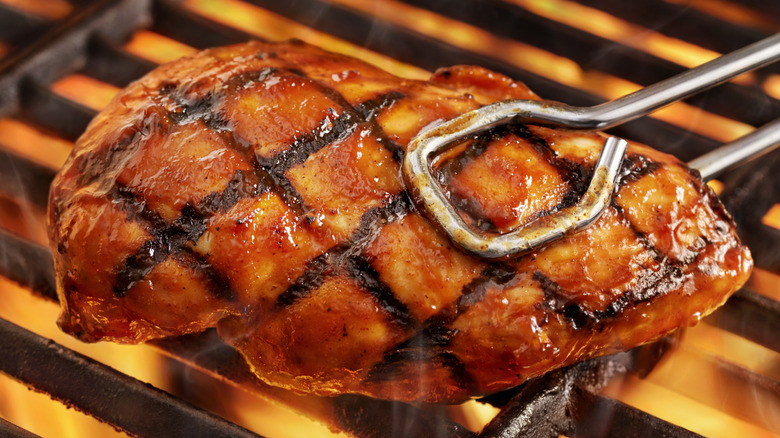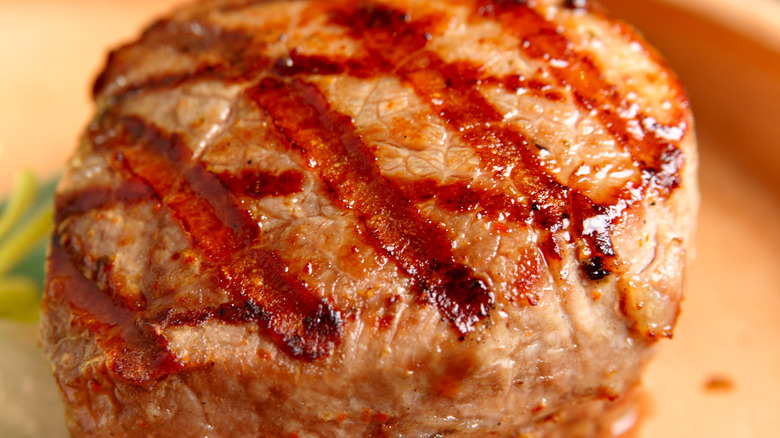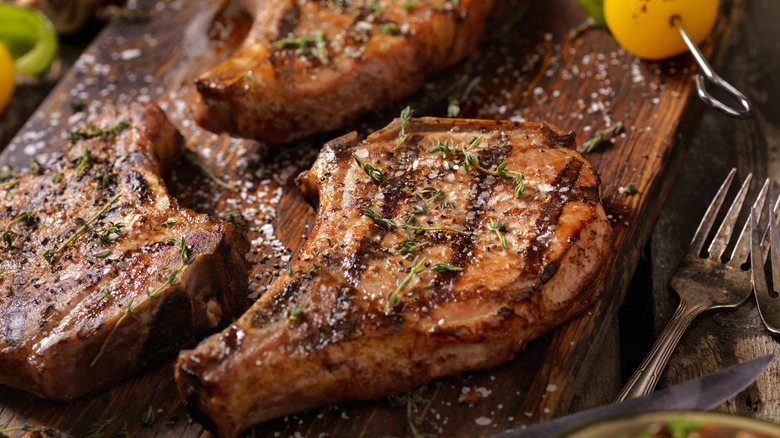How To Get Those Dazzling Crosshatch Grill Marks On Your Meat
There are so many top tips for prepping meat like a pro, from selecting the best cuts of steak and how to cook them, to adding lemon juice to make steak scientifically more delicious. However, when it comes to presentation, nothing beats being served a juicy piece of beef marked with gorgeously neat grill marks. It looks instantly appetizing, and if you learn to do it properly at home, it's guaranteed to impress.
There are two main types of grill marks you'll see on meat: single strip marks and crosshatch. Both boil down to angles when it comes to achieving the most visually appealing result. Although crosshatch is slightly trickier, involving two sets of angles, it truly delivers a picture-perfect steak. This method also looks great on other types of meat, burgers, chicken, fish, or even grilled vegetables, such as slices of eggplant and zucchini.
Also known as quadrillage — from the French "quadriller," meaning "to square" — the technique for achieving the criss-cross, diamond-shaped pattern across the surface of the meat all comes down to how it is rotated as it cooks. The meat is only moved four times in total, first being placed at a 45-degree angle and then at 90 degrees before being flipped to repeat each angle, to create the signature square shapes on each side. While it requires a bit of practice and patience, once you've mastered the angles and rotation, you'll be dishing up Instagram-worthy creations in no time at all.
Sear at a 45 degree angle, then rotate 90 degrees
To start the process, place the meat on a grill that has been pre-heated, positioning it at that 45-degree angle; to achieve the perfect sear evenly across the surface, apply a little pressure to gently press the protein down. Once you notice the sides of the meat begin to lift, after a couple of minutes depending on size, use a grilling spatula or tongs to very carefully lift an edge to check on how the grill marks are developing. But don't pull the whole piece up or move it, or else you risk creating extra marks that will disrupt the neat pattern.
Once you are satisfied with the initial branded marks, you will need to rotate the protein or vegetable 90 degrees to create the crosshatch design. Try to move it to a new hot spot on the grill at this point, which will be hotter than where your food has already been cooking. When ready, turn the item over and repeat the two angles on the other side. Again, do not move the food once it's in position to avoid messing up the marks.
It's worth noting that the second side may not be quite as well-branded, as a steak may be cooked to your liking before it has a chance to develop the marks. If that's the case, once you've allowed the meat to rest after grilling, simply serve the neatest-looking side face-up for the most attractive presentation.
More tips to create a neater sear when grilling meat
When attempting quadrillage, there are a few tips that will help to create a better result. It's important that the grill itself is clean before you start, so don't attempt the technique on a dirty grill as you won't get a tidy sear. Spend time cleaning the grill bars before you fire up to make sure the protein or vegetable releases easily when it's time to turn them. Rubbing the grates with a bit of oil will help to prevent the meat or fish from sticking too much, and it's worth lightly oiling the food itself, too.
Cast iron grates or a grill topper will deliver the best sear marks, and the grill should also be fully pre-heated (for at least 10 to 15 minutes) before you begin if you want to get clear markings. Ensure steaks have come to room temperature before you grill them so that they cook evenly; then use a thermometer to check the internal temperature, so you know exactly when to take them off the grill.
If you've marinated the protein to make it extra-tender, remove any excess before grilling by wiping it; this reduces the risk of it flaring up while cooking and also means you'll get a better-flavored piece of meat that doesn't just taste of the grill. And if you're serving your perfectly crosshatched steak sliced, then slice it against the grain, so it's even more tender and juicy.



